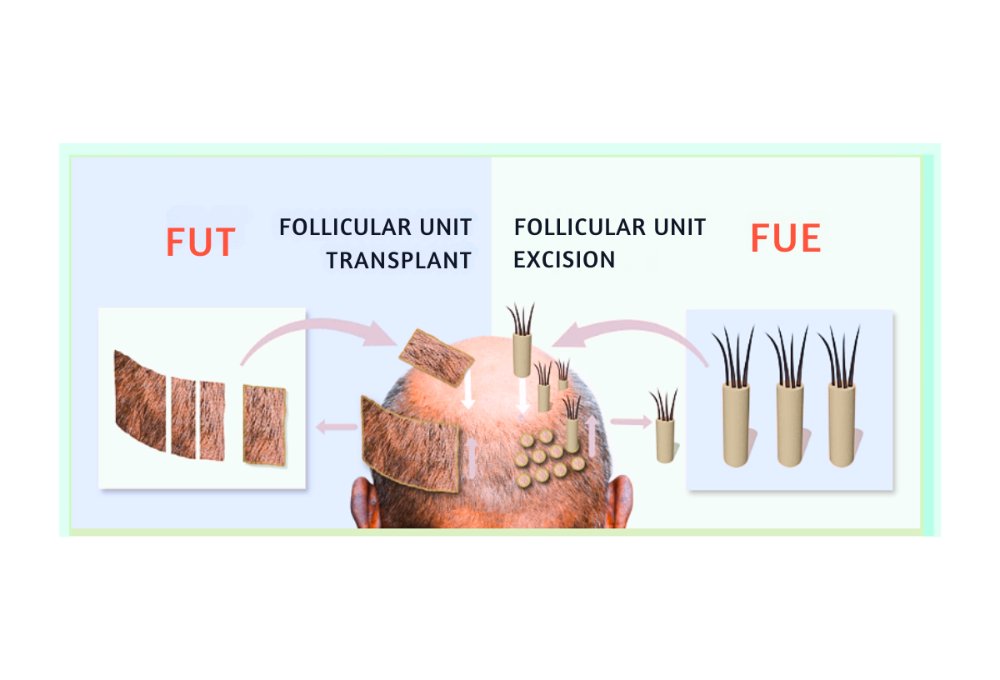Are you contemplating a hair transplant but are tangled in the FUE vs FUT debate? You’re not alone! These two hair restoration techniques are now the standards for combating hair loss, yet choosing between them can be as perplexing as understanding the science behind hair growth itself. In this article, we’ll dive deep into the FUE and FUT procedures, dissecting every aspect to help you make an informed decision.
Types of Hair Transplants – FUE & FUT Summary
FUE Hair Transplant
Follicular Unit Excision (FUE) is a hair transplant method in which individual hair follicles are directly taken from the donor area, usually located at the back of the head. This method involves precise, circular incisions to isolate and extract each follicular unit. The appeal of FUE lies in its minimal invasiveness and absence of linear scarring, making it a famous choice for those who prefer shorter hairstyles.
FUT Hair Transplant
On the other hand, Follicular Unit Transplantation (FUT) entails extracting individual hair follicles from a strip of skin taken from the donor area and transplanting them. This technique is often favoured for its efficient harvesting of many grafts in a single session. However, it does leave a small linear scar, which might be a consideration for those who like to keep their hair short.
How Much Do Hair Transplants Cost?
The hair transplant cost can vary widely based on several factors including the type of surgery (FUT/strip vs. FUE), the severity of your hair loss, the condition of your donor area, your desired outcome, the number of grafts needed, and some additional considerations that might be unique to you.
Benefits – FUE & FUT
Hair transplantation has become increasingly famous as a solution for hair loss, offering both Follicular Unit Excision (FUE) and Follicular Unit Transplantation (FUT) as viable options.
Each technique presents its own set of benefits, catering to the different preferences or needs of individuals seeking hair restoration.
FUE Benefits:
Minimal Scarring:
Follicular Unit Excision (FUE) leaves tiny, dot-like scars scattered across the donor area. These scars are significantly less conspicuous than the linear scar associated with Follicular Unit Transplantation (FUT), making FUE an attractive option for individuals who prefer wearing shorter hairstyles or wish to keep their hair cropped close to the scalp. The minimally invasive nature of FUE allows for more discreet harvesting of hair follicles, resulting in a more natural-looking outcome.
Less Postoperative Discomfort:
The minimally invasive nature of FUE translates to reduced postoperative discomfort for patients. Because FUE involves extracting individual hair follicles using tiny punches, there is less scalp trauma than the strip harvesting method employed in FUT. Consequently, patients undergoing FUE typically experience less pain, swelling, and bruising postoperatively. This diminished discomfort contributes to a quicker recovery, enabling individuals to resume their daily routines with minimal interruption.
Flexibility in Hair Styles:
One of the standout advantages of FUE is its flexibility in hair styling. Since FUE leaves minimal scarring, patients have greater freedom to experiment with various hairstyles, including shorter cuts and hairdos that involve parting or styling the hair in different directions. The absence of a noticeable linear scar allows for more versatility in concealing the donor area, enabling individuals to confidently wear their hair in styles that best suit their preferences and lifestyle.
FUT Benefits:
Higher Graft Yield:
Follicular Unit Transplantation (FUT) remains a preferred choice for patients requiring many grafts to address extensive hair loss. Unlike FUE, which extracts individual follicular units one at a time, FUT involves removing a strip of tissue from the donor area, usually located at the back or sides of the scalp. Consequently, FUT particularly benefits patients with advanced hair loss or those seeking maximum coverage and density.
Cost-Effectiveness:
From a financial standpoint, FUT often proves to be more cost-effective than FUE for individuals seeking hair restoration treatment. FUT’s efficiency in harvesting many grafts in a single session translates to a lower cost per graft than FUE. This cost advantage makes FUT an appealing option for patients who prioritize affordability without compromising on the quality of results.
Time Efficiency:
Another notable advantage of FUT is its time efficiency, making it a convenient choice for patients with busy schedules or time constraints. The procedure typically requires less time than FUE, primarily due to the streamlined process of harvesting grafts from a single strip of tissue. This time-saving aspect of FUT can be advantageous for individuals seeking efficient hair restoration solutions without prolonged surgical sessions, allowing them to achieve their desired aesthetic goals with minimal disruption to their daily routine.
Candidates – FUE & FUT
FUE Candidates:
It is ideal for individuals with a lesser degree of hair loss, who prefer shorter haircuts, and who have sufficient donor hair.
FUT Candidates:
It is best suited for those experiencing significant hair loss and who require a larger number of grafts. This method is also ideal for individuals who don’t mind the linear scar or plan to wear their hair at a length that conceals it.
Average Cost – FUE & FUT
While costs can fluctuate, on average, FUE can range from $4,000 to as much as $20,000 or more whereas FUT can range from $3,000 to $11,000 or more. The final cost depends on several factors such as the type of surgery (FUT/strip vs. FUE), the number of grafts needed, the degree of your hair loss, the condition of your donor area, your desired outcome, and some additional considerations that might be unique to you.
Success Rate – FUE & FUT
The success rate of both FUE and FUT is remarkably high, with many patients experiencing significant hair growth post-procedure. However, FUE might have a slightly lower yield due to the possible transection (damage) of follicles during extraction. Nevertheless, with technological advancements and a skilled surgeon, the gap in success rates between these two methods is narrowing.
Conclusion
Deciding between FUE and FUT for hair restoration is a personal choice influenced by factors like your lifestyle, budget, extent of hair loss, and personal preferences regarding recovery and scarring. Both methods have their unique benefits and can yield impressive results.
It’s paramount to consult with a qualified hair restoration specialist to assess your specific situation and guide you toward the best choice for your hair goals. Remember, your journey to restoring your hair should be as unique as you are!






